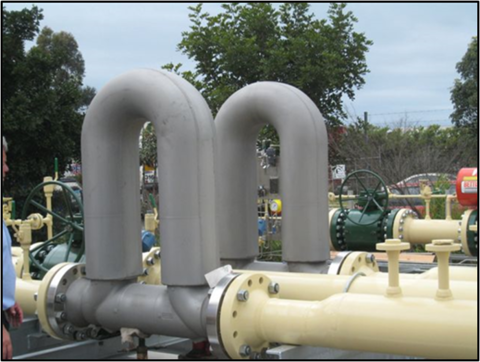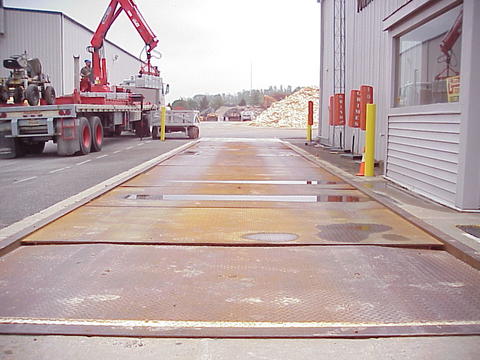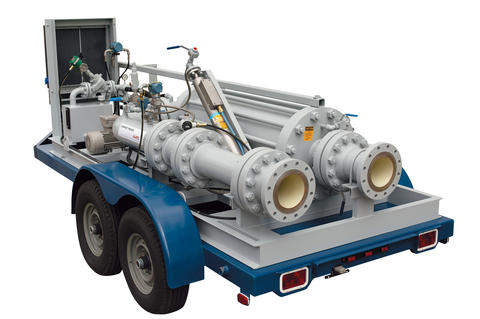Weights and measures inspections provide a legally required, independent validation of the accuracy of commercial weighing and measuring devices; provide a level playing field for competing businesses; and help ensure consumers get what they pay for and businesses receive accurate payment for the goods and services they sell. But what happens when weights and measures programs lack the necessary standards and equipment to conduct verification tests on a particular type of device? Do such devices simply go unregulated? How does this impact consumers and businesses that rely on the assurances provided by official inspections? The practice of “witness testing” provides a solution to help ensure protections for consumers and businesses alike.
Emerging technologies such as commercial electric vehicle chargers and other alternative fuels sometimes require specialized test standards or equipment to carry out adequate testing to ensure marketplace protections and verify compliance with weights and measures laws and regulations. Even applications that are not “emerging” or “unique” may pose a challenge for routine inspection and testing when test standards are not readily available to or practical for a weights and measures jurisdiction to obtain. Many jurisdictions have long employed the practice of “witness testing” as an efficient approach for testing applications such as large metering systems, railway track scales, belt-conveyor scales, automatic bulk weighing systems, or even prepackaged commodities.
This article describes the concept of witness testing, factors that lead to its use and associated benefits, and approaches that can be used by weights and measures programs to effectively use the practice to conduct an official weights and measures inspection and test. This article is the first in a short series of articles designed to highlight the elements of witness testing and help jurisdictions expand its use.
What is Witness Testing?
Witness testing is “the practice in which the weights and measures official conducts an official inspection and test using test standards and equipment owned or supplied by the owner of the device or packaged commodities.” Put simply, the device owner provides the test standards, equipment, and operators; and the weights and measures inspector uses these resources to carry out an official inspection and test -- just as they would if using test equipment provided by the weights and measures agency.
Jurisdictions that adopt NIST Handbook 44 can reference requirements in the General Code to require the device owner or operator to supply the necessary equipment and labor to carry out witness testing.
G-UR.4.4. Assistance in Testing Operations. – If the design, construction, or location of any device is such as to require a testing procedure involving special equipment or accessories or an abnormal amount of labor, such equipment, accessories, and labor shall be supplied by the owner or operator of the device as required by the weights and measures official.
Who is Responsible for the Testing Process?

A key element of witness testing is that it does not confer the authority to the device owner or service company to direct the official test. Just as with any official weights and measures examination, the weights and measures official is in charge of and directs all aspects of the witness testing. This includes specifying the type and validity of the required test standards and associated equipment as well as directing the specifics of the inspection and test, including the number and type of accuracy tests conducted and the procedures used. Note, however, that it is highly recommended the official not operate test equipment not owned by their jurisdiction; instead, only direct the equipment operator to carry out specific procedures.
Witness testing as historically used by weights and measures programs to conduct inspections of devices such as railway track scales, belt-conveyor scale systems, bulk weighing systems, large meters, and other devices that may require the use of specialized or costly test equipment or where operators and other personnel may possess unique training or certifications needed to carry out the testing.
Availability of Test Equipment
A key driver in the use of witness testing can be the availability of test equipment. The availability and/or decision to procure test equipment can be impacted by a variety of factors such as:
- lack of funding (for example, a large volumetric prover can cost $75,000 or more and may require a specially equipped vehicle to transport it);
- the specialized nature of the test standards (many test standards are custom-built and because demand is relatively low, few companies manufacture them, further limiting their availability);
- the limited number of the specific type of commercial weighing or measuring device in the jurisdiction relative to the cost of the standards (for example, compressed natural gas or hydrogen fuel dispensers are few in number, but test standards and equipment can be costly); and
- the limited availability in the jurisdiction of test standards for newer technologies and applications such as electric vehicle fueling systems.
This lack of test standards has the potential to leave some types of commercial weighing and measuring devices essentially incorrect and, where it is unlawful to use an incorrect device (see NIST Handbook 130, Uniform Weights & Measures Law, Section 21. Prohibited Acts) in violation of weights and measures laws. The possible economic impact to the buyer and seller from unverified and possibly inaccurate measurements can be huge on many of these devices, particularly those such as large meters or scales which are used in transactions involving large quantities of products.
So, what alternatives exist to provide assurances to consumers and businesses of device accuracy and use? This is where the practice of “witness testing” can help.
Benefits of Witness Testing

Without a weights and measures inspection, a commercial weighing or measuring device may go uninspected, leaving consumers and businesses without the confidence of measurements verified by an independent inspection. Failure to inspect and test commercial devices can lead to fraudulent commercial practices and a lack of uniformity among states, which can have a negative impact on interstate commerce. This can also impact consumer confidence in marketplace integrity and honesty, potentially discouraging the acceptance of new technologies and emerging applications.
This method of testing sometimes allows an official to test a commercial device that would otherwise go untested, thus providing a clear benefit to the buyer, the seller, other competing businesses, and any third party ---- just like the test of any other commercial device using conventional testing methodology. Without a regulatory presence, businesses also have fewer choices and support for resolving measurement disputes.
Using the practice of “witness testing,” a competent weights and measures official can conduct a test of a commercial weighing or measuring device using test standards and equipment owned and operated by the owner/operator of that device (or the owner’s service agent) and still maintain the necessary rigor and traceability of standards required for an official inspection.
Further, this practice allows weights and measures programs to maximize the use of limited taxpayer resources, including making cost-benefit decisions regarding the purchase of costly test equipment that may only be used on a small number of devices. Since commercial weighing and measuring device owners are required to verify the accuracy and compliance of their devices regardless of whether weights and measures officials are routinely inspecting and testing them, officials can make use of those resources, possibly scheduling and combining the tests with limited impact on the device owner.
Responsibility of Device Owners vs. Weights and Measures Programs
Some device owners mistakenly believe they can rely solely on weights and measures inspections to verify the accuracy of their commercial weighing or measuring devices before putting them into use. The reality is that device owners have a responsibility to ensure the commercial devices they use comply with all applicable requirements, including accuracy before placing the device into service.
This is reinforced by requirements in NIST Handbook 44 (adopted in some form by all states) that require the device owner to maintain and use the devices within applicable requirements (see paragraph G-UR.4.1. Maintenance of Equipment and other “User Requirements” in the General Code).
G-UR.4.1. Maintenance of Equipment. – All equipment in service and all mechanisms and devices attached thereto or used in connection therewith shall be continuously maintained in proper operating condition throughout the period of such service. Equipment in service at a single place of business shall not be considered “maintained in a proper operating condition” if:
(a) predominantly, equipment of all types or applications are found to be in error in a direction favorable to the device user; or
(b) predominantly, equipment of the same type or application is found to be in error in a direction favorable to the device user.(Amended 1973, 1991, and 2015)

Weights and measures programs vary in their policies and practices regarding how device owners place their devices into service. For example, whether the owner is permitted to use the device prior to a weights and measures verification or if they must wait for an official initial verification; whether a registered service agency must be used to place the device into service; or if there are other steps that must be taken. Regardless of individual practices, most states require that commercial weighing and measuring devices comply with the current or an earlier edition of NIST Handbook 44 and relevant packaging and labeling requirements (NIST Handbook 130, Uniform Weights and Measures Law, Sections 4 and 5) and that prohibit the device owner (NIST Handbook 130, Uniform Weights and Measures Law, Section 21 Prohibited Acts) from using any incorrect weight or measure. Thus, making the owner responsible for ensuring compliance before using a device or selling a packaged product.
An official weights and measures inspection is a law enforcement function, not a testing service. The purpose of the weights and measures inspection is to verify that device owners are maintaining and using a commercial weighing or measuring device in accordance with applicable requirements. The decision to inspect and test a specific device is based on factors such as compliance history, age of the device, available resources, and economic impact on the parties involved. Thus, even if a weights and measures program does not inspect and test a specific device, this does not relieve the device owner from taking necessary steps to regularly ensure the accuracy of their device and compliance with applicable requirements. Nor does it permit device owners to install and use devices commercially without verifying their accuracy and compliance with NIST Handbook 44 or other state requirements.
Getting Started
So, how does a weights and measures official go about doing a “witness test” of a weighing or measuring device or a packaged commodity?
The overall process for a field examination conducted using witness testing is essentially the same as that of any routine weights and measure field examination, but there are some differences involved in preparing for the test. Want more details on how to get started? NIST OWM is developing a short course on how to conduct inspections using witness testing, which covers the elements of conducting witness testing in more detail and is considering offering this course in a webinar format. In the meantime, look for additional articles in subsequent OWM newsletters for more details on getting started on the steps outlined above to prepare for and conduct a witness test.

